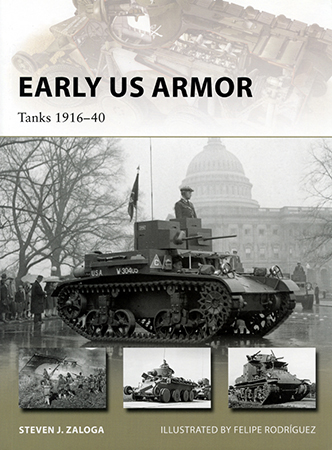
Early US Armor: Tanks 1916-40 Book Review
By David L. Veres
| Date of Review | April 2017 | Title | Early US Armor: Tanks 1916-40 |
|---|---|---|---|
| Author | Steven J. Zaloga | Publisher | Osprey Publishing |
| Published | 2017 | ISBN | 9781472818072 |
| Format | 48 pages, softbound | MSRP (USD) | $18.00 |
Review
America's mighty armored forces of World War II owed victory to technology, equipment and doctrine forged over the previous quarter century.
That premise helps fuel Steven J Zaloga's superb little Early US Armor – number 245 in Osprey Publishing's popular "New Vanguard" range.
Subtitled "Tanks 1916-40", coverage chronologically charts the total tale in just 48 densely detailed pages. Contents include:
- American Tank Origins
- The Tank Corps
- Tank Corps Disbanded
- Early Christie Tanks
- Rock Island Arsenal Tanks
- The Christie Distraction
- Knox's Light Tanks
- Combat Cars and Infantry Tanks
- Calvary Combat Cars
- Infantry Light Tanks
- Increasing Armor and Firepower
- The M2 Medium Tank
- Marine Corps Tanks
- Export Tanks
- In Retrospect
Zaloga adeptly addresses the era's political, military and economic forces. And personalities play major roles.
Like Harry A Knox, who designed the iconic vertical volute suspension and rubber block track. And the idiosyncratic J Walter Christie.
Sections on Christie proved, I thought, the book's most provocative parts. But Christie, Zaloga notes, "did not have the perseverance or patience to convert an intriguing design into a functional and reliable machine".
Failures in US Army service, Christie convertible designs nevertheless spawned Britain's Cruiser tanks and Soviet Russia's legendary T-34. So who knows? Had J Walter Christie displayed greater business, engineering and, yes, social acumen, America might have produced a T-34 analog.
Extended captions and informative tables support the study. B&W photos and a solitary contemporary color shot also augment the account. And notes on USMC and export armor further spice the saga.
Felipe Rodríguez's action artwork is excellent. His splendid cut-away aptly illumines Christie's convertible concept. And his ten superb profiles sample the swath of US between-wars camouflage schemes. More from Mr Rodríguez, please.
An index and selected bibliography conclude contents.
Grab this terrific little tome. Then – please – lobby Osprey and Steven J. Zaloga for a sequel on J Walter Christi's innovative armor designs.
Rabidly recommended!
My sincere thanks to Osprey Publishing for this review sample!







